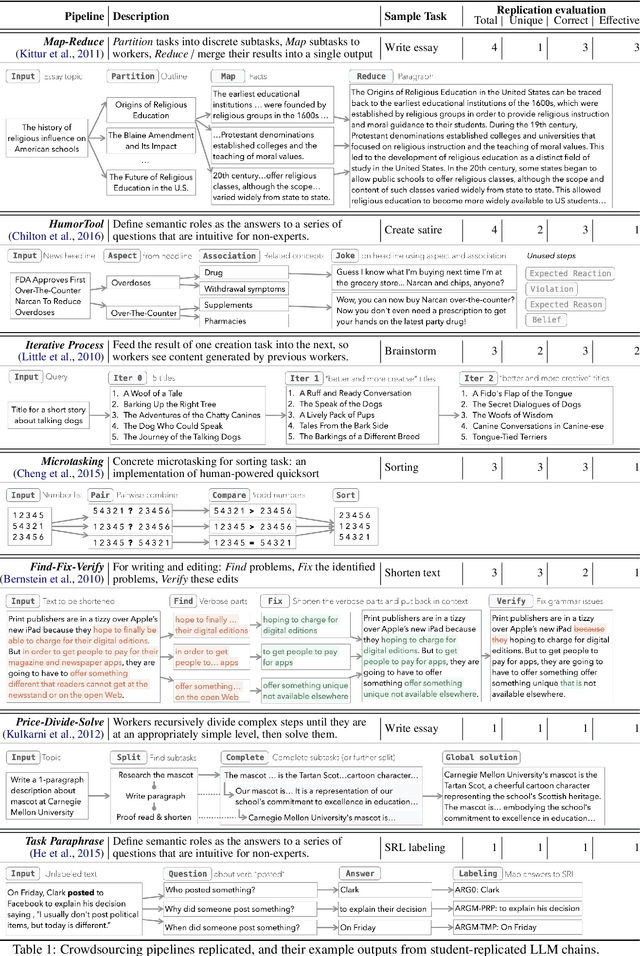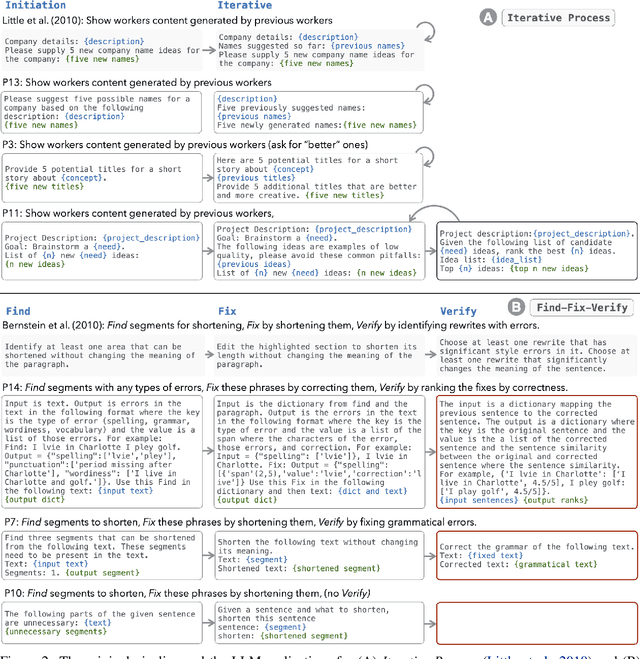Jeremiah Milbauer
Michael Pokorny
Beyond Text: Characterizing Domain Expert Needs in Document Research
Apr 16, 2025Abstract:Working with documents is a key part of almost any knowledge work, from contextualizing research in a literature review to reviewing legal precedent. Recently, as their capabilities have expanded, primarily text-based NLP systems have often been billed as able to assist or even automate this kind of work. But to what extent are these systems able to model these tasks as experts conceptualize and perform them now? In this study, we interview sixteen domain experts across two domains to understand their processes of document research, and compare it to the current state of NLP systems. We find that our participants processes are idiosyncratic, iterative, and rely extensively on the social context of a document in addition its content; existing approaches in NLP and adjacent fields that explicitly center the document as an object, rather than as merely a container for text, tend to better reflect our participants' priorities, though they are often less accessible outside their research communities. We call on the NLP community to more carefully consider the role of the document in building useful tools that are accessible, personalizable, iterative, and socially aware.
Humanity's Last Exam
Jan 24, 2025Abstract:Benchmarks are important tools for tracking the rapid advancements in large language model (LLM) capabilities. However, benchmarks are not keeping pace in difficulty: LLMs now achieve over 90\% accuracy on popular benchmarks like MMLU, limiting informed measurement of state-of-the-art LLM capabilities. In response, we introduce Humanity's Last Exam (HLE), a multi-modal benchmark at the frontier of human knowledge, designed to be the final closed-ended academic benchmark of its kind with broad subject coverage. HLE consists of 3,000 questions across dozens of subjects, including mathematics, humanities, and the natural sciences. HLE is developed globally by subject-matter experts and consists of multiple-choice and short-answer questions suitable for automated grading. Each question has a known solution that is unambiguous and easily verifiable, but cannot be quickly answered via internet retrieval. State-of-the-art LLMs demonstrate low accuracy and calibration on HLE, highlighting a significant gap between current LLM capabilities and the expert human frontier on closed-ended academic questions. To inform research and policymaking upon a clear understanding of model capabilities, we publicly release HLE at https://lastexam.ai.
Stereotype or Personalization? User Identity Biases Chatbot Recommendations
Oct 08, 2024Abstract:We demonstrate that when people use large language models (LLMs) to generate recommendations, the LLMs produce responses that reflect both what the user wants and who the user is. While personalized recommendations are often desired by users, it can be difficult in practice to distinguish cases of bias from cases of personalization: we find that models generate racially stereotypical recommendations regardless of whether the user revealed their identity intentionally through explicit indications or unintentionally through implicit cues. We argue that chatbots ought to transparently indicate when recommendations are influenced by a user's revealed identity characteristics, but observe that they currently fail to do so. Our experiments show that even though a user's revealed identity significantly influences model recommendations (p < 0.001), model responses obfuscate this fact in response to user queries. This bias and lack of transparency occurs consistently across multiple popular consumer LLMs (gpt-4o-mini, gpt-4-turbo, llama-3-70B, and claude-3.5) and for four American racial groups.
From Nuisance to News Sense: Augmenting the News with Cross-Document Evidence and Context
Oct 06, 2023Abstract:Reading and understanding the stories in the news is increasingly difficult. Reporting on stories evolves rapidly, politicized news venues offer different perspectives (and sometimes different facts), and misinformation is rampant. However, existing solutions merely aggregate an overwhelming amount of information from heterogenous sources, such as different news outlets, social media, and news bias rating agencies. We present NEWSSENSE, a novel sensemaking tool and reading interface designed to collect and integrate information from multiple news articles on a central topic, using a form of reference-free fact verification. NEWSSENSE augments a central, grounding article of the user's choice by linking it to related articles from different sources, providing inline highlights on how specific claims in the chosen article are either supported or contradicted by information from other articles. Using NEWSSENSE, users can seamlessly digest and cross-check multiple information sources without disturbing their natural reading flow. Our pilot study shows that NEWSSENSE has the potential to help users identify key information, verify the credibility of news articles, and explore different perspectives.
LLMs as Workers in Human-Computational Algorithms? Replicating Crowdsourcing Pipelines with LLMs
Jul 20, 2023


Abstract:LLMs have shown promise in replicating human-like behavior in crowdsourcing tasks that were previously thought to be exclusive to human abilities. However, current efforts focus mainly on simple atomic tasks. We explore whether LLMs can replicate more complex crowdsourcing pipelines. We find that modern LLMs can simulate some of crowdworkers' abilities in these "human computation algorithms," but the level of success is variable and influenced by requesters' understanding of LLM capabilities, the specific skills required for sub-tasks, and the optimal interaction modality for performing these sub-tasks. We reflect on human and LLMs' different sensitivities to instructions, stress the importance of enabling human-facing safeguards for LLMs, and discuss the potential of training humans and LLMs with complementary skill sets. Crucially, we show that replicating crowdsourcing pipelines offers a valuable platform to investigate (1) the relative strengths of LLMs on different tasks (by cross-comparing their performances on sub-tasks) and (2) LLMs' potential in complex tasks, where they can complete part of the tasks while leaving others to humans.
LAIT: Efficient Multi-Segment Encoding in Transformers with Layer-Adjustable Interaction
May 31, 2023



Abstract:Transformer encoders contextualize token representations by attending to all other tokens at each layer, leading to quadratic increase in compute effort with the input length. In practice, however, the input text of many NLP tasks can be seen as a sequence of related segments (e.g., the sequence of sentences within a passage, or the hypothesis and premise in NLI). While attending across these segments is highly beneficial for many tasks, we hypothesize that this interaction can be delayed until later encoding stages. To this end, we introduce Layer-Adjustable Interactions in Transformers (LAIT). Within LAIT, segmented inputs are first encoded independently, and then jointly. This partial two-tower architecture bridges the gap between a Dual Encoder's ability to pre-compute representations for segments and a fully self-attentive Transformer's capacity to model cross-segment attention. The LAIT framework effectively leverages existing pretrained Transformers and converts them into the hybrid of the two aforementioned architectures, allowing for easy and intuitive control over the performance-efficiency tradeoff. Experimenting on a wide range of NLP tasks, we find LAIT able to reduce 30-50% of the attention FLOPs on many tasks, while preserving high accuracy; in some practical settings, LAIT could reduce actual latency by orders of magnitude.
 Add to Chrome
Add to Chrome Add to Firefox
Add to Firefox Add to Edge
Add to Edge